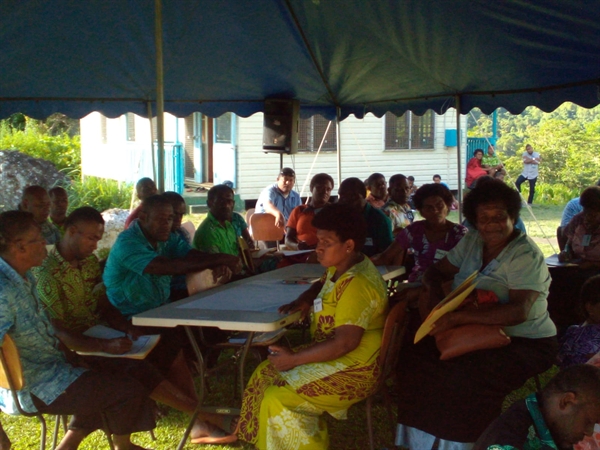
On a sunny Tuesday morning in April 2021, the districts of Namosi, Wainikoroiluva, Veinuqa, and Naqarawai in the interior of Namosi gathered for catchment management training. They met at the newly commissioned Namosi Government Station in Dada, for 2 days of information sharing and deliberation, to identify actions to better manage their catchment to protect their natural water sources.
The training, funded by the Watershed Interventions for Systems and Health in Fiji (WISH Fiji) project, through the Fiji National University and conducted by the Provincial Office and the Provincial Administrator’s Office, was aimed at water and health committees, village headmen, and district representatives. The focus of the workshop was to discuss how catchment management could serve as a tool to protect safe and clean drinking water to rural communities. Results from the 2019 baseline surveys undertaken in the five villages of Navunikabi, Saliadrau, Naqarawai, Wainimakutu and Naraiyawa were shared which included data on the high E. coli bacteria counts found across multiple water sources used by the villages. Given similarities in vegetation types, land terrain and land use patterns within the wider catchment, the results might be representative of the wider area encompassing 18 villages in the Upper Navua region.
As stated by the Water Authority of Fiji, water should always be clean without contaminants farming and livestock, and run-off from poorly designed sanitation. During the training, different sector representatives such as the Namosi Provincial Office, Ministry of Regional Development, Ministry of Agriculture, Ministry of Forestry, Ministry of Health and Medical Services, Department of Water and Sewerage, and Water Authority all shared potential solutions on how to address and reduce water source contamination.
Using a template from the Water Authority of Fiji, actions plans were developed which included the fencing of animals or water sources to protect contamination from animals, as well as the importance of maintaining 200 meter buffer areas around water sources. Communities considered the condition of their dam and the reservoir – for example, were they in a good working condition? Did they need maintenance? Were there any leakages in the pipeline? And what activities occurred around water pipelines, including if there were leaking sanitation structures near pipelines. The critical roles and responsibilities of water and health committees in maintaining clean and safe drinking water in their communities was highlighted.
The training resulted in committees putting together specific, measurable, achievable, realistic, and time-defined solutions which will help promote and maintain safe and clean drinking water in their villages.
This blog was produced by Kini Koto, Fiji National University